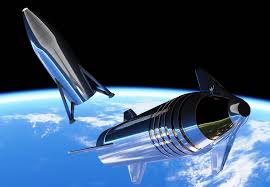SpaceX’s Starhopper Hops Higher

An artist’s concept of what the completed Starship will look like. Courtesy of SpaceX.
SpaceX’s new Starship Spacecraft vehicle, called the Starhopper, executed its first test flight on April 5. This test flight, known as a “hop,” involved the vehicle taking off while tethered to the ground and lasted less than a minute. The Starhopper “hit tether limits,” as Elon Musk, the CEO of SpaceX, said in a tweet, indicating that it did just as SpaceX hoped it would.
The current Starhopper is a prototype of the Starship, which is part of Musk’s Starship project. According to Firstpost, the Starhopper is “the smaller, scaled version of the actual spacecraft.” The prototype utilizes a single Raptor rocket engine, which was developed by SpaceX, to achieve its liftoff. Musk told Firstpost that the single engine still does not take the craft very high. According to BGR, the aforementioned test was also restricted by the tethers, which were used to “test [the spacecraft’s] engines and other vital systems to see how they respond to real-world stresses.”
Eventually the plan is to put three engines on the vehicle in order to achieve much higher “hops.” According to Vox, “such flights would take the vehicle to low altitudes in the atmosphere before slowly lowering the ship back to the ground.” Other tests of the same kind were conducted in 2012 and 2013 on Grasshopper, a test version of SpaceX’s Falcon 9 rocket, to try out the landing technique that the company employs after most of its launches. SpaceX’s goal with the Starhopper and the Starship project is to improve the ship’s power and its capability to land on other worlds, such as the Moon or Mars.
The Starship was originally called the BFR, or the Big Falcon Rocket. It was renamed “The Starship” recently by Musk, and its first stage was called the “Super Heavy.” According to SpaceX, the Starship and Super Heavy “represent a fully reusable transportation system designed to service all Earth orbit needs as well as the Moon and Mars.” Earth’s “orbit needs” include servicing satellites and transporting cargo and people between the surface and space stations.
Musk has outlined a very ambitious schedule for the Starship project. According to Spac, Musk plans to conduct a few unmanned cargo missions to Mars and a manned roundtrip mission to the Moon. The latter mission’s tickets have been purchased by Japanese billionaire Yusaku Maezawa. By 2024, SpaceX may be ready to conduct crewed missions to Mars. This may provide the platform for eventually creating settlements on other planets. Before we know it, science fiction may soon become a reality. SpaceX’s space ventures continue to show that the possibilities in space are endless.





